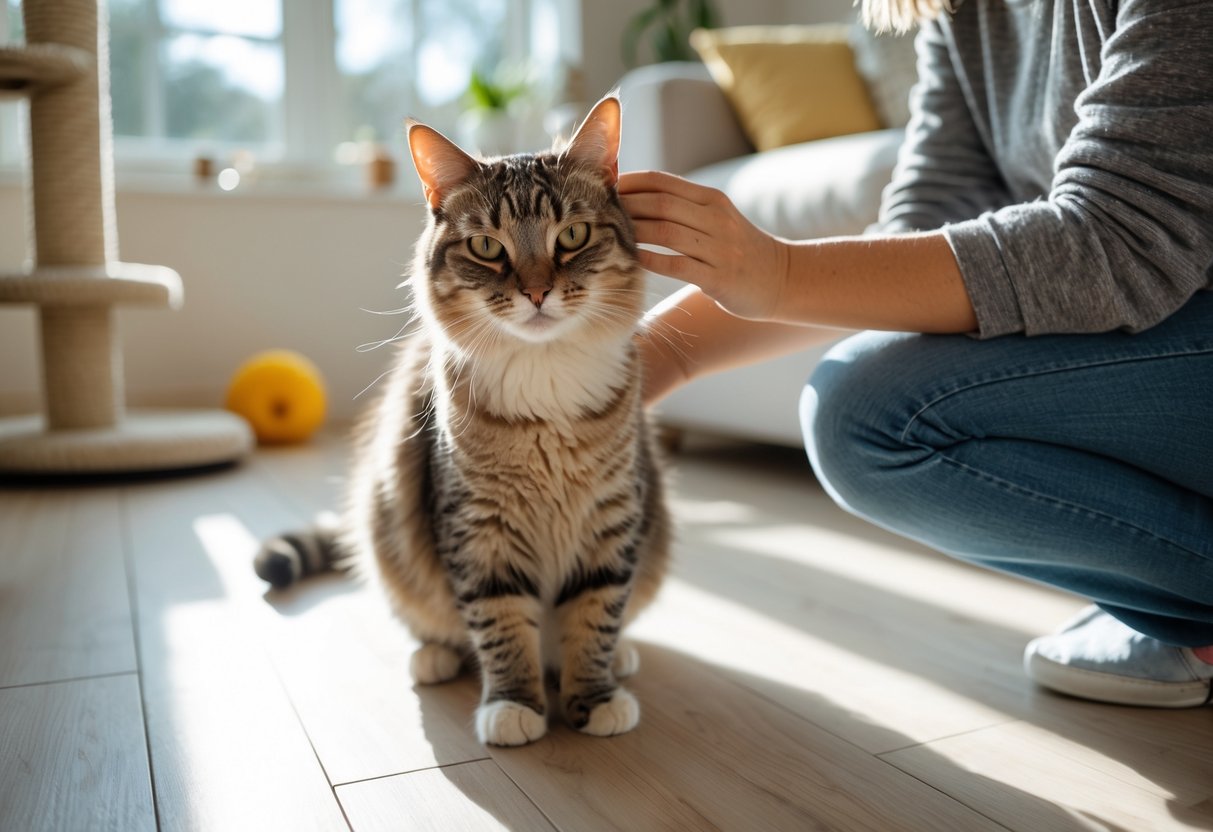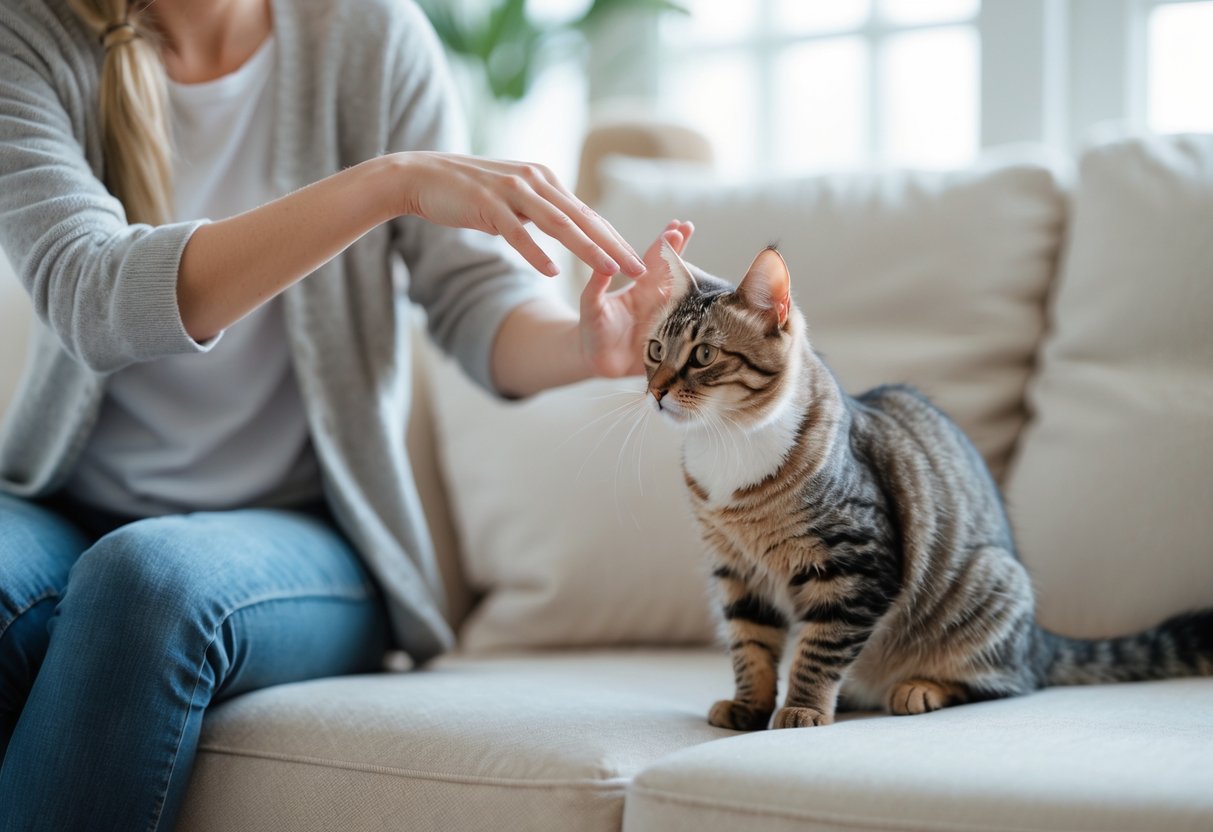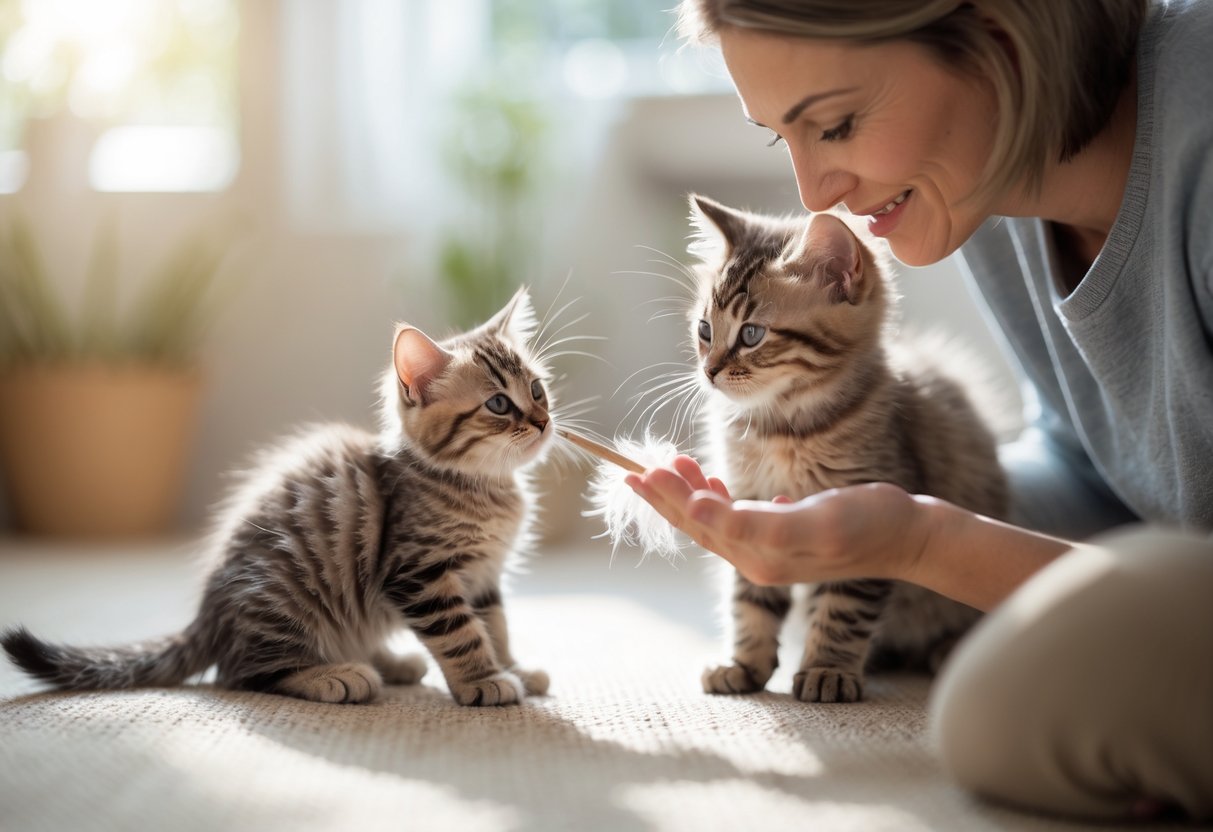Physical Address
304 North Cardinal St.
Dorchester Center, MA 02124
Physical Address
304 North Cardinal St.
Dorchester Center, MA 02124

If your cat is biting, you might feel confused or worried. Cats bite for different reasons, like play, fear, or even to get your attention. You can help stop your cat from biting by understanding what triggers the behavior and using gentle training.

Paying attention to your cat’s body language and redirecting their energy to toys are good ways to prevent bites. Simple changes around your home and regular playtime can also make your cat less likely to nip at you.

Cats bite for several reasons, ranging from communication and play to fear or stress. By learning the signs and triggers for cat biting, you can respond in ways that protect both you and your cat. Each cat is different, but these patterns are common in most homes.
Most cat biting has clear triggers. Cats may bite if they feel scared, stressed, or annoyed. Biting can also happen if your cat is in pain or not feeling well.
Many cats bite during play, especially if their hunting instincts kick in. Overstimulation is another big reason; too much petting or handling can make some cats react with a nip. Sometimes, cats will bite to get your attention, such as when they want to be left alone or need food or water.
Here are a few common triggers:
Paying close attention to when and where your cat bites helps you spot patterns and adjust your own actions.
Not all cat bites mean the same thing. Some are gentle nibbles or “love bites,” while others are stronger and may signal stress or fear.
It helps to watch how hard your cat bites and what is going on around them. This gives you clues about what your cat is trying to tell you.
Understanding your cat’s body language can help you avoid being bitten. Cats show their feelings through their ears, tail, eyes, and overall body stance.
Look for these signs before biting:
| Body Part | Warning Sign | What it Means |
|---|---|---|
| Ears | Flattened or back | Fear or irritation |
| Tail | Flicking or thrashing | Agitation or annoyance |
| Eyes | Wide, dilated pupils | Excitement, fear, or stress |
| Body | Tense or crouching | Feeling defensive or scared |
If you see your cat’s tail flick, ears flatten, or eyes widen, give them some space. This can help you stop bites before they happen. Watching for small changes in your cat’s body language is the best way to know how they are feeling and when it’s time to back off.

Stopping your cat from biting takes patience, clear routines, and timely action. Identifying why your cat bites helps you choose the best solution, whether your pet is biting out of play, stress, or discomfort.
Cats often bite when they feel playful or overstimulated. Instead of letting your cat bite your hands or feet, keep toys nearby when you play. Wand toys, stuffed mice, or balls let your cat use their hunting instincts safely.
When you see signs your cat is about to bite—like flicking their tail or flattening their ears—change their focus to a toy. Try tossing a small ball or sliding a toy across the floor. This teaches your cat where it’s okay to bite.
Avoid roughhousing with your hands or feet. This can make your cat think it’s fine to bite skin. Consistent redirection helps your cat learn what’s allowed and keeps their playtime safe for everyone.
Cats learn best when rules stay the same. If your cat starts to bite, say “no” in a calm but firm voice. Stop playing right away and move your hand out of reach. Walk away or give your cat a short break from attention.
Make sure everyone in your home reacts the same way. If one person allows biting but others do not, your cat may get confused. Post a simple list of rules somewhere visible for all family members:
| Situation | Response |
|---|---|
| Cat starts biting | Say “no” and stop interacting |
| Cat tries again | Ignore and leave the room |
Setting clear boundaries helps your cat understand biting is not how to get your attention. Over time, your cat will learn accepted behaviors through repetition.
Reward your cat for gentle play or calm behavior. When your cat uses toys instead of biting you, offer a treat, petting, or kind words. Positive reinforcement encourages your cat to repeat good behavior.
Clicker training can work well with some cats. Click and treat right after your cat makes a good choice. Keep training sessions short and end on a positive note.
Be patient. Cats may need many tries before they change a habit. Stay consistent with rewards, and avoid hitting or yelling, which can frighten your cat and make biting worse. Over time, your cat will connect gentle behavior with good things.

Kittens often bite because they are learning about their world and practicing hunting skills. Teaching your cat how to play nicely at this stage helps prevent biting as they grow older.
Kittens love to chase, pounce, and bite as part of their natural play. These activities help them practice hunting, which is an important part of cat behavior.
Biting during play is normal for young cats, but if not managed, this habit can continue into adulthood. Playful nips rarely mean the kitten is angry. Instead, they are usually exploring boundaries or reacting to movement.
Make sure your kitten has plenty of cat toys such as balls, feather wands, or soft mice. Redirect biting from your hands or feet to toys. Avoid using your hands as toys, since this teaches your cat that your skin is okay to bite.
Keep play sessions short and positive. If biting gets too rough, stop play for a few minutes so your kitten learns that gentle play gets rewarded but hard bites end the fun.
When kittens grow up with their littermates, they learn social rules. Frequent wrestling and play fights help teach bite control. If a kitten bites too hard, a sibling usually yelps and stops playing.
Littermate play teaches:
If possible, let your kitten stay with its litter until at least 8 weeks old. This gives them time to learn from their siblings. If you have an only kitten, try gently exposing them to other friendly cats or kittens for short, supervised playtimes.
If biting gets out of hand, try interrupting with a soft “ouch” or by stopping the game. This mimics how littermates react and helps your kitten learn good manners.
To teach your cat not to bite, be consistent with your reactions. When your kitten bites, stop the play immediately. Wait until your kitten calms down before starting to play again.
When your kitten uses toys instead of your hands, offer praise or a treat. Positive reinforcement helps your kitten understand which behaviors are wanted.
You can also make a list of gentle correction methods:
| Correction | What To Do |
|---|---|
| Stop play | Pause interaction |
| Gentle verbal cue | Say “no” or “ouch” quietly |
| Redirect to toy | Offer a chew or wand toy |
Do not yell or hit your kitten. This will damage your bond and make them fearful. With patience, clear rules, and lots of appropriate play, you can help your kitten grow into a gentle adult cat.
Your cat may bite when they feel anxious, fearful, or are in pain. Understanding why your cat bites and how to respond helps keep both you and your pet safe and comfortable.
Cats often show signs before they bite. Look for body language such as flattened ears, a twitching tail, dilated pupils, or hissing. These signs can mean your cat is scared or stressed.
Sometimes, cats will hide more often or avoid being touched. Pay attention to changes in daily habits like eating, grooming, or using the litter box. If your cat suddenly becomes more vocal, avoids people, or grooms themselves less, they might be uncomfortable.
It’s important to watch and learn your cat’s usual behavior. If you notice any sudden changes, it could signal anxiety or pain.
To help your cat feel safe, create a calm and predictable environment. Keep loud noises to a minimum and provide a quiet space where your cat can relax. Use feline pheromone diffusers, which can help some cats feel secure.
Give your cat scratching posts, safe hiding spots, and places to climb. These items let your cat act on natural behaviors and feel more at ease. Sticking to a regular routine also helps lower stress.
Do not force interactions. Let your cat come to you for attention. Gently play with your cat using toys, not your hands, to reduce play aggression and avoid bites.
Quick Tips to Lower Stress:
If your cat’s biting seems sudden or the behavior changes quickly, make an appointment with your vet. Pain from injury, dental trouble, or illness can make cats bite when touched.
Your vet can check for hidden medical issues and pain. They may suggest treatment or medicine if needed. Keeping up with regular health check-ups can also catch problems early.
If stress and anxiety are ongoing, your vet might recommend a behaviorist. Professionals can guide you in changing your cat’s environment or routine to help reduce biting.
Enrichment and trust help cats feel safer and happier in your home. When you meet your cat’s needs, they are less likely to bite and more likely to bond with you.
Cats need both mental and physical activities to stay healthy and calm. Boredom or unused energy can lead to biting, especially during playtime. Try adding a mix of toys such as:
Rotate your cat’s toys every few days to keep their interest. Spend a few minutes each day in interactive play sessions. Use toys that encourage chasing, pouncing, and jumping. Avoid using your hands or fingers as toys, which can encourage rough play and biting.
For mental enrichment, use treat-dispensing toys or hide small amounts of food to encourage natural hunting behaviors. Provide places to climb, like cat trees or shelves. A window perch can be a great way for your cat to watch birds and other outdoor activities, giving them something interesting to look at.
Trust is key to stopping fear-based biting. Always approach your cat calmly and let them come to you. Learn their body language:
Use positive reinforcement, like giving treats or gentle petting when your cat behaves calmly. If your cat shies away, give them space and do not force interaction. Consistency in feeding, play, and quiet time helps your cat know what to expect, making them feel safer.
Try to spend quiet time with your cat—reading or watching TV together—without expecting interaction. This lets your cat relax near you and build trust at their own pace.
Safe handling reduces the risk of accidental bites. Always move slowly and speak softly when you approach your cat. Let them sniff your hand before petting.
If you need to pick up your cat, support their body with both hands—one under the chest and one under the hind legs. Avoid restraining them tightly, as this can cause fear and lead to defensive biting.
Respect your cat’s signals. If they try to leave or show signs of discomfort (flattened ears, growling, or hissing), stop what you are doing. Teach family members to do the same.
If grooming or nail trims are stressful for your cat, start with short, gentle sessions and offer treats. Taking breaks or using calming products like pheromone sprays can also help make handling easier and safer.
Cat biting can happen for different reasons, like play, petting, or even at night. Understanding the cause of your cat’s biting is important so you can use the right methods to stop it.
Redirect your cat’s energy into toys or play sessions when you notice they are about to bite. Avoid using your hands as toys.
Give your cat plenty of mental and physical stimulation with scratching posts, puzzle feeders, and daily play. If your cat gets rough, calmly walk away to show biting ends the fun.
Watch your cat’s body language. If their tail starts twitching, ears flatten, or skin ripples, that’s a sign they might be getting overstimulated.
Stop petting before these signs show up. Give your cat space and let them come back to you when they feel ready.
Some cats give gentle “love bites” when they feel playful or want attention. These can also happen if your cat gets overstimulated or feels too excited.
Learn your cat’s cues, like sudden stillness, pupil changes, or tail swishing, to better predict when a bite might happen.
Biting during affection often means your cat has had enough petting. It’s a common way for cats to set boundaries.
Try to keep petting sessions short and only touch areas your cat enjoys, like the head or cheeks.
Neutered male cats are less likely to bite due to hormones. If your male cat is aggressive, offer regular play for his energy.
If biting happens, calmly stop play and ignore your cat for a few minutes. Never yell or hit.
Provide a big play session before bedtime to tire your cat out. Nighttime biting can be caused by pent-up energy or boredom.
Give your cat interactive toys to play with at night if they are active while you sleep. Close your bedroom door if your cat is too playful during sleeping hours.
[…] For cats who bite, try redirecting their attention with toys or treats, and remember that patience is key. Consistent daily routines help reduce cat stress and make sudden aggression in cats less likely to happen. For tips on how to safely stop biting, try reading about how to stop a cat from biting. […]
Thank you for your thoughtful comment! You’re absolutely right — redirecting attention and using positive reinforcement can make a big difference when dealing with sudden aggression. It’s always great to hear from cat owners who understand the importance of patience and consistency. 😊